Novus Ordo Francis Burgess propers (AUG)
-
Since first encountering the Anglican Use Gradual, I have always thought that there should be a similar resource for the Novus Ordo gradual. In the intervening years, lots of other Novus Ordo propers resources have come out, some setting the 3rd edition missal and some the Gradual. And recently, the St. Peter Gradual updating the AUG (and it's ancestor, The English Gradual, vol. II) to the approved Roman Catholic text of the Divine Worship missal.
But no one has done the AUG/English Gradual in Novus Ordo style. So I decided to give it a shot.
I would appreciate advice on the samples posted below. If anyone uses any of them at mass, please let me know how they work!
Engraving challenges:
- I engraved in modern notation because I am faster with it than with GABC. Plus, haven't gotten my choir on square notes quite yet.
- I engraved in stemmed notation, because I can't figure out how to group the stemless note heads in a way that makes them look like neumes.
Texts:
- The no official translations of the Gradual is a big issue for this sort of project.
- When they match, I use the texts of the Roman Missal, 2011. When texts don't match (most of the time), I am using a combination of the Roman Missal, 1965 and the Gregorian Missal of Solesmes. The Solesmes texts are sometimes more literal to the original texts, and it is really difficult to track down where a chant came from in the pre-Novus Ordo scheme. -
These are really really good!
Your syllabification is excellent.
Your chants sing themselves - as well they should!
P-B couldn't but be pleased - and impressed. -
Thanks Jackson. I used Roman tradition melodies instead of Anglican tradition melodies in the introit and Alleluia verses, and the first verse of the Gradual. I figure that people using this are in the Roman/Latin tradition vs the Anglican. Are you ok with that? or do you think I should stick with Burgess' melodies?
-
David, this is fantastic. I wholeheartedly endorse this project and hope you continue. I always liked the AUG
-
Thanks David! That's a fantastic work!
-
Thank you, David! This is really solid! Great job! :)
-
If you do do any further adaptation of the P/B stuff, someone kindly encoded the whole collection into GABC, which you can find on gregobase and github, I believe. That will save you some trouble if you decide to render anything in square note notation anyway.
As for stemless notation, it is certainly my preference (for the little that's worth). I've found that simply grouping them close together under a slur usually renders a nice result. I'm attaching one example here. Really, you can experiment with even tighter spacing if desired / appropriate. The fact remains that you can't "neumify" modern notation, although you can still get close enough for government work.
One reason I personally advocate for stemless is that it removes the temptation to apply particular rhythmic interpretation. It's really hard to tell someone to ignore a tone of 8th stems, that they are counseled to pay attention to the rest of the time. (It can also become very cluttered.) Conversely, I've found that when transcriptions are stemless, people approach the music with a more neutral slate, and are more inclined to follow natural speech rhythms because that other superfluous data is stripped away and cannot influence them. Just a thought.
Regardless, the examples you have shared thus far are very nicely done. AND! I really appreciate that you use reciting tones when multiple syllables / words take the same pitch. That is SO MUCH nicer than a bajillion 8th notes all in a row.
EDIT: here's a second example with tighter spacing intended to imitate neume spacing more closely.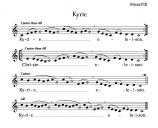
 Screenshot 2023-01-13 at 11.47.27 AM.jpg1508 x 1222 - 213K
Screenshot 2023-01-13 at 11.47.27 AM.jpg1508 x 1222 - 213K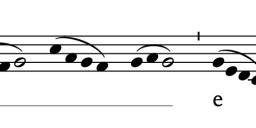
 Screenshot 2023-01-13 at 11.53.12 AM.jpg1508 x 252 - 53KThanked by 1DavidOLGC
Screenshot 2023-01-13 at 11.53.12 AM.jpg1508 x 252 - 53KThanked by 1DavidOLGC -
One might expect so. There was a very lively thread on Anglican Musicians List though about the 'whole note' being 4 times as long.stemless … removes the temptation to apply particular rhythmic interpretation. -
That’s why I use the half notehead. Black for short/flowing, white for “long” (appropriate as per context) and then double wholes as reciting tones. Something about the bars/wings on the sides that make you treat them differently in a chant context.
-
Serviam, how do you group notes more tightly like that? That’s a useful trick
-
You know me, I'm a rather [in]famous fan of Dorico... So what I do is:
1. lower the default note spacing for the layout (Dorico has 4 spaces to the quarter for default. Something closer to 2 often works as a good launching point.)
2. I also apply a custom spacing ratio to something low like 1.10, so that noteheads more/less receive the same rhythmic spacing regardless of their value. This is how you end up with a score that allotts equal spacing to black and white noteheads, which is actually what we want in this context.
3. Lastly, I will go into engrave mode and use the note spacing tool, and manually contract each grouping of "neumes" until they look good to the eye. (Mind you, steps 1 and 2 already brought the notes pretty close together, which saves a lot of labor.) I often leave the first note untouched so that there is a larger bit of space between each group, and only contract subsequent notes. You can see the notes I contracted have the red handles in the pic below.
It's all very easy and fluid to do in Dorico because it gives you total control over these parameters (and truly supports open meter, so you don't have to apply a time signature and hide it... rather, you simply plop barlines where you want them. Simple as that.)
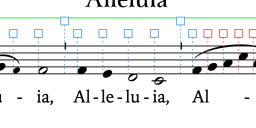
 Screen Shot 2023-01-16 at 9.04.27 AM.png1752 x 392 - 90K
Screen Shot 2023-01-16 at 9.04.27 AM.png1752 x 392 - 90K -
I used Lilypond for the scores posted above, and I use it for most of the engraving I do. I like the copy/paste functionality of text based editing, very useful for lyrics and sharing melodies between scores. Lilypond’s cadenza feature also makes it simple to enter non-metered music. What is difficult, is grouping note heads like Serviam does. Lilypond’s default spacing is tough alter and manually moving note heads is tough and unattractive.
I think the best solution for Lilypond would be to build custom multi-note stemless noteheads that represented the Gregorian neums. Each grouping of notes would then be treated by the spacing engine as a single note head, and no tweaking of note head spacing would be necessary. Ideal.
Bartlett and Co. found a solution, because all their modern notation stuff is engraved in Lilypond. I suspect it is what I describe above, but not sure. -
I had no idea Bartlett used Lilypond. For the SEP too? I presumed that was some LaTeX stuff.
I experiment with GABC from time to time, including the new S&S editor, but one major gripe I have with GABC defaults is the seemingly arbitrary way it decides when/where to insert hyphens. When you look at the PBC, it is utterly maddening because no one went back and manually normalized where they appear. (My own preference being to add them so that every syllable has them the way modern music does; this makes placement of the syllables more accurate to the neumes for people who aren't familiar with latin and are iffy square note readers, but I digress...) -
What you have provided is excellent. You might also consult the Rossini Propers to provide a bit of variety.
https://media.musicasacra.com/pdf/rossini_propers.pdf -
Nostalgia for the Blue Book! Good work!
I was in a discussion yesterday about the alleged notational illiteracy of S. Texas Hispanic church musicians, and suggested that maybe there needed to be a NO Rossini in Spanish. I hadn't thought of there not being a NO Rossini in English. (Actually, there WAS a Rossini in English, but it was for the transitional Mass.)
Thanked by 1Roborgelmeister -
Serviam,
SEP was engraved by Stephen van Roode I believe using GABC. Not sure if he also used TEX or InDesign, etc.
Parish Book of Chant was engraved by Richard Rice. I think he uses Meinrad fonts and MS Word.
Both gentlemen are forum contributors and could better comment on their own work.
I’m pretty sure the accompaniment materials for Lumen Christi Missal and the Lumen Christi hymnal were both typeset using using Lilypond, as is the modern notation chant in the Source and Summit Missal and all the modern notation and accompaniment material generated by the source and summit online platform. I don’t think Adam Bartlett did this work personally, but instead served as the guiding genius in leveraging the open source software Lilypond and GABC for use in an online application that is fulfilled in the Source and Summit editor. -
Jeffrey, I think a blue book or Rossini in English is an important link in actualizing sung propers.
I bought SEP for my choir this year, but between only 1 person already reading square notes and the other choristers who don’t read any music, SEP is just too much to tackle on a regular basis unless all other choral music is halted.
However, something like this with the same tone every week… we could squeeze this in. -
The Rossini makes me giggle every time I look at it. The presentation is just so obnoxious and unusable in its original format. (I’m not saying it isn’t good work; just that the typesetting was totally unrealistic.)
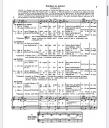
 E5B58F59-80A8-4D0F-B4D2-53DE9252C0BD.jpeg1125 x 1317 - 754KThanked by 1tomjaw
E5B58F59-80A8-4D0F-B4D2-53DE9252C0BD.jpeg1125 x 1317 - 754KThanked by 1tomjaw -
I had no idea Bartlett used Lilypond. For the SEP too? I presumed that was some LaTeX stuff.
SEP was typeset with Gregorio + Illustrator + InDesignThanked by 1ServiamScores -
Advent

 002 Advent II.pdf189K
002 Advent II.pdf189K
 003 Advent III.pdf325K
003 Advent III.pdf325K
 004 Advent IV.pdf405K
004 Advent IV.pdf405K
 001 Advent I.pdf406K
001 Advent I.pdf406K -
Christmas

 005 Christmas Vigil.pdf287K
005 Christmas Vigil.pdf287K
 006 Christmas Midnight.pdf410K
006 Christmas Midnight.pdf410K
 007 Christmas Dawn.pdf409K
007 Christmas Dawn.pdf409K
 008 Christmas Day.pdf287K
008 Christmas Day.pdf287K -
Christmas season

 009 Holy Family.pdf288K
009 Holy Family.pdf288K
 010 Mary, Mother of God.pdf446K
010 Mary, Mother of God.pdf446K
 011 Second Sunday after Christmas.pdf287K
011 Second Sunday after Christmas.pdf287K
 012 Epiphany.pdf286K
012 Epiphany.pdf286K
 013 Baptism of the Lord.pdf364K
013 Baptism of the Lord.pdf364K -
Serviam,
It wasn't until I went somewhere where I HAD to read those weird pages, that I realized how the Introit Gloria Patri worked with the verse. I have people who insist on flipping back in the Liber Brevior to the Gloria Patri pages; I've been trying to teach them the easier way, but they like that security blanket.Thanked by 1tomjaw -
Lent 1-5

 015 Lent I.pdf292K
015 Lent I.pdf292K
 016 Lent II.pdf290K
016 Lent II.pdf290K
 017 Lent III.pdf299K
017 Lent III.pdf299K
 018 Lent IV.pdf289K
018 Lent IV.pdf289K
 019 Lent V.pdf292K
019 Lent V.pdf292K -
My issue isn’t the GP’s; it’s that it is too easy to get lost if you are the organist reading the top, or singers reading week 4 at the bottom. Granted, the more you do this, you get used to it pretty quickly (it is formulaic after all), but I would have restricted myself to two weeks per page.
-
Trying these now in stemless notation. Been playing a lot of Source and Summit scores this spring and getting used to the clean, spare look of stemless. So I spent some time with Lilypond to try to replicate their results. Not quite as nice as Source and Summit, but at least it looks like it's from the 21st century.
Thoughts?
 047 SOT 10.pdf288K
047 SOT 10.pdf288K
 048 SOT 11.pdf283KThanked by 1DavidOLGC
048 SOT 11.pdf283KThanked by 1DavidOLGC -
I am also a huge fan of stemless notation. I think these are a definite improvement. The only thing I would add is that regularizing the spacing would be welcome. Personally, I would condense things a bit so the relationship of the pitches is clearer and leave the appropriate amount of white space at the end of each line. (Stum - ble is so spread out it's almost hard to tell if the pitch goes down or stays the same, for instance. Condensing it, and situations like it, so it's easier to read would be nice.)
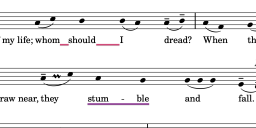
 Screenshot 2023-06-06 at 9.54.52 AM.png2288 x 854 - 107KThanked by 1DavidOLGC
Screenshot 2023-06-06 at 9.54.52 AM.png2288 x 854 - 107KThanked by 1DavidOLGC -
Wow!!!!!! These settings sing themselves. Ease of reading helps. Thank so much, davido.
-
I have gone back and done some revisions. Inching closer to completing the whole Sunday cycle.
Obviously final revisions will be needed at that point, but these are close.
Here is Advent.
 001 Advent 1.pdf406K
001 Advent 1.pdf406K
 002 Advent 2.pdf406K
002 Advent 2.pdf406K
 003 Advent 3.pdf325K
003 Advent 3.pdf325K
 004 Advent 4.pdf405K
004 Advent 4.pdf405K -
Christmas

 005 Christmas Vigil.pdf409K
005 Christmas Vigil.pdf409K
 006 Christmas Midnight.pdf409K
006 Christmas Midnight.pdf409K
 007 Christmas Dawn.pdf411K
007 Christmas Dawn.pdf411K
 008 Christmas Day.pdf406K
008 Christmas Day.pdf406K -
Holy Family, Mary Mother of God, Second Sunday of Christmas, Epiphany, Baptism of the Lord

 009 Holy Family.pdf423K
009 Holy Family.pdf423K
 010 Mary, Mother of God.pdf445K
010 Mary, Mother of God.pdf445K
 011 Second Sunday after Christmas.pdf417K
011 Second Sunday after Christmas.pdf417K
 012 Epiphany.pdf407K
012 Epiphany.pdf407K
 013 Baptism of the Lord.pdf356K
013 Baptism of the Lord.pdf356K -
Ash Wednesday and Lent

 015 Lent 1.pdf456K
015 Lent 1.pdf456K
 014 Ash Wednesday.pdf481K
014 Ash Wednesday.pdf481K
 016 Lent 2.pdf441K
016 Lent 2.pdf441K
 017 Lent 3.pdf443K
017 Lent 3.pdf443K
 018 Lent 4.pdf423K
018 Lent 4.pdf423K
 019 Lent 5.pdf436KThanked by 1Joseph Michael
019 Lent 5.pdf436KThanked by 1Joseph Michael -
Holy Week

 020 Palm Sunday.pdf591K
020 Palm Sunday.pdf591K
 021 Chrism Mass.pdf378K
021 Chrism Mass.pdf378K
 022 Holy Thursday.pdf692K
022 Holy Thursday.pdf692K
 023 Good Friday.pdf1M
023 Good Friday.pdf1M
 024 Easter Vigil.pdf683KThanked by 1Joseph Michael
024 Easter Vigil.pdf683KThanked by 1Joseph Michael -
Easter Sunday.

 025 Easter Sunday.pdf511K
025 Easter Sunday.pdf511K -
These become embedded in the memory very easily.
I saw a few multisyllabic words in cadences that were not hyphenated. -
Easter 2-6

 026 Easter 2.pdf417K
026 Easter 2.pdf417K
 027 Easter 3.pdf440K
027 Easter 3.pdf440K
 028 Easter 4.pdf412K
028 Easter 4.pdf412K
 029 Easter 5.pdf442K
029 Easter 5.pdf442K
 030 Easter 6.pdf538K
030 Easter 6.pdf538K -
Rob, do you think that impacts readability? I am letting Lilypond is determine most of the hyphenation and line breaks.
-
Yes, I think hyphenation is always a good assist. It seems to me that it is unwise to have some hyphens in some places, but not in others, especially because some could construe it as an error, and it might mislead others.
Carlo Rossini's Propers of the Mass to Psalm Tones is easily adaptable to English... someone did it for the 1965 English Translations. There is more variety in the psalm tones used than in the Burgess.
Bud Clark, whose name still crops up here, advocated using psalm tones selected to match the mode of the item in the Graduale. BTW, he despised the Burgess work.
All this having been said, this is a monumental work, and you are to be thanked for your hard work. -
Here is a first draft of the whole thing, currently called the St. Francis Gradual. Entrance-Gradual-Alleluia-Offertory-Communion for Sundays-Solemnities-Feasts.
There are probably typos, please let me know if you see any.

 ST_Francis_Gradual_combined.pdf24MThanked by 1CHGiffen
ST_Francis_Gradual_combined.pdf24MThanked by 1CHGiffen -
Having reached completion in the arranging/engraving side, I now have run into ICEL copyright. My impression is that distributing this for free on the internet will not trigger any royalty issues with ICEL, but that printing and selling copies would.
Is this true even on a LULU sale at cost? -
Your best bet is to ask ICEL and/or an IP lawyer. I can probably recommend you one.
*having reviewed the license and having phoned a friend (though said friend reminds me that this is not strictly speaking legal advice), you probably want to ask for a reasonable flat fee. It may be worth your time asking an IP attorney to do this; it might not be worth theirs (i.e. it’s definitely billable.) -
Thanks. Thats the answer I was afraid of.
Welcome to the MusicaSacra Forum!
To participate in the discussions on Catholic church music, sign in or register as a forum member, The forum is a project of the Church Music Association of America.
Categories
- All Discussions21,164
- General Music Discussion8,241
- Job Openings204
- Management of Music Programs850
- Choral Matters533
- Church Documents and Rubrics526
- CMAA Notes304
- Events720
- For Newcomers: Read First26
- Sacred Polyphony547
- Hymnody872
- Gregorian Chant: General2,703
- ↳ Graduale Romanum and Liber Usualis369
- ↳ Graduale Simplex60
- ↳ Semiology63
- Vernacular Plainsong696
- Anglican Use and Anglican Chant68
- Organ, Other Instruments and Repertoire435
- New Composition/Works in Progress1,295
- Recordings234
- Music for Hispanic Ministry159
- Music Education: Children211
- Music Education: General222
- News Items245
- Positions Wanted2
- General Discussion: Catholicism740
- Amusements177
- General Discussion1,035
- Opinions119




